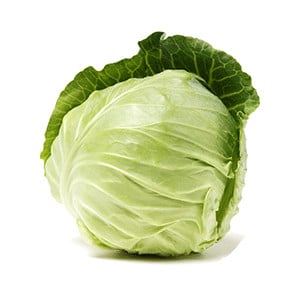Gemüsekohl - Weißkohl / Weißer Spitzkohl

Gemüsekohl - Weißkohl / Weißer Spitzkohl
Brassica oleracea convar. capitata var. alba
Plant family
Kreuzblütler (Brassicaceae)
Also known as
Weißkohl, Kraut, Weißkraut, Kohl, Weißkabis, Kappus, Kobis, Kaps, Kappes, Spitzkraut, Spitzkabis, Filderkraut
Cultivation Break
3 Years
Season Overview
Propagating
Planting
Harvest
J
F
M
A
M
J
J
A
S
O
N
D
Details
Light requirement
Sunny
Water requirement
Wet
Soil
Medium (loamy)
Nutrient requirement
High
Plant distance
60 cm
Row spacing
60 cm
Seeding depth
1.5 cm
Instructions
The season for this plant is over. The following instructions are for the next season.
Mid of April
Vorziehen
Mid of April
Jäten
Every week
End of April
pikieren
Description
Kopfkohl ist eine heimische Kultur aus der Familie der Kreuzblütler. Er lässt sich bis spät in den Herbst hinein ernten und eignet sich hervorragend für das Winterlager.
Origin:
Europa
Growing tips
Kohl bevorzugt humose, kalkhaltige, tiefgründige, etwas schwerere Erde an einem sonnigen Standort. Gleichmäßige Wasser-und Nährstoffversorgung sind während des Wachstums wichtig. Beim Pflanzen von Setzlingen sollte die Erde feucht sein und die Setzlinge sollten gut angegossen werden. Eine letzte Ernte im Winter ist möglich, da Kohl Minusgrade verträgt. Um auf der sicheren Seite zu sein, kannst du ihn aber trotzdem mit einem Vlies abdecken.
Companion Plants
Artischocke
Aubergine
Bohne (Ackerbohne)
Bohne (Buschbohne)
Bohne (Stangenbohne)
Borretsch
Chili
Dill
Dost, Oregano, Majoran
Erbse
Gurke
Kamille
Kartoffel
Koriander
Kümmel
Lauch
Mangold
Minze
Möhren
Paprika
Pastinake
Physalis
Radieschen
Rettich
Rhabarber
Ringelblume
Rüben / Bete
Salat (Endivien / Frisée)
Salat (Feldsalat)
Salat (Gartensalat)
Salat (Radicchio)
Salbei
Schnittlauch
Sellerie (Knollensellerie)
Sellerie (Stangensellerie)
Sojabohne
Spinat (Sommer)
Thymian
Antagonistic Plants
Erdbeere
Fenchel
Gemüsefenchel
Gemüsekohl - Blumenkohl / Romanesco
Gemüsekohl - Brokkoli
Gemüsekohl - Grünkohl / Braunkohl
Gemüsekohl - Kohlrabi
Gemüsekohl - Palmkohl / Schwarzkohl
Gemüsekohl - Rosenkohl
Gemüsekohl - Wirsing / Butterkohl
Knoblauch
Liebstöckel
Meerrettich
Okra
Raps - Steckrübe
Rosmarinminze
Rübsen - Chinakohl
Rübsen - Komatsuna
Rübsen - Pak Choi
Rübsen - Speiserübe
Topinambur
Zwiebel
Zwiebel (Frühlingszwiebel)
Diseases
No diseases
Pests
No pests